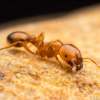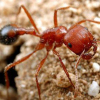Pheidole are tiny, just like Solenopsis molesta, Monomorium, Temnothorax, and several others. Small would be something like Lasius or Tetramorium.
This blanket statement is nonsense. Pheidole are the second most diverse ant genus on the planet, with (queen) sizes ranging from <3mm to 18mm. Pheidole dentata are definitely a "small" species, with the minors being 2.5-3mm. I do agree with Drew, going with the tiny option is probably smart just for peace of mind, but generically saying that Pheidole is a genus of only small ants is just not correct.
I am well aware of the size variations in Pheidole species. However, I don't see how 18 mm Pheidole queens who don't exist in North America have anything to do with the situation on hand!
Uh... 18mm Pheidole ONLY exist in North America. Ever heard of Pheidole rhea?
That's a 28mm tube for reference.
Either way, yes, it is relevant to bring up the size variation in Pheidole. P. dentata are the 3rd largest Pheidole species in the eastern US, and are most certainly not on-par in size with the genera that you had listed.
Edited by CheetoLord02, August 15 2020 - 7:57 PM.






















